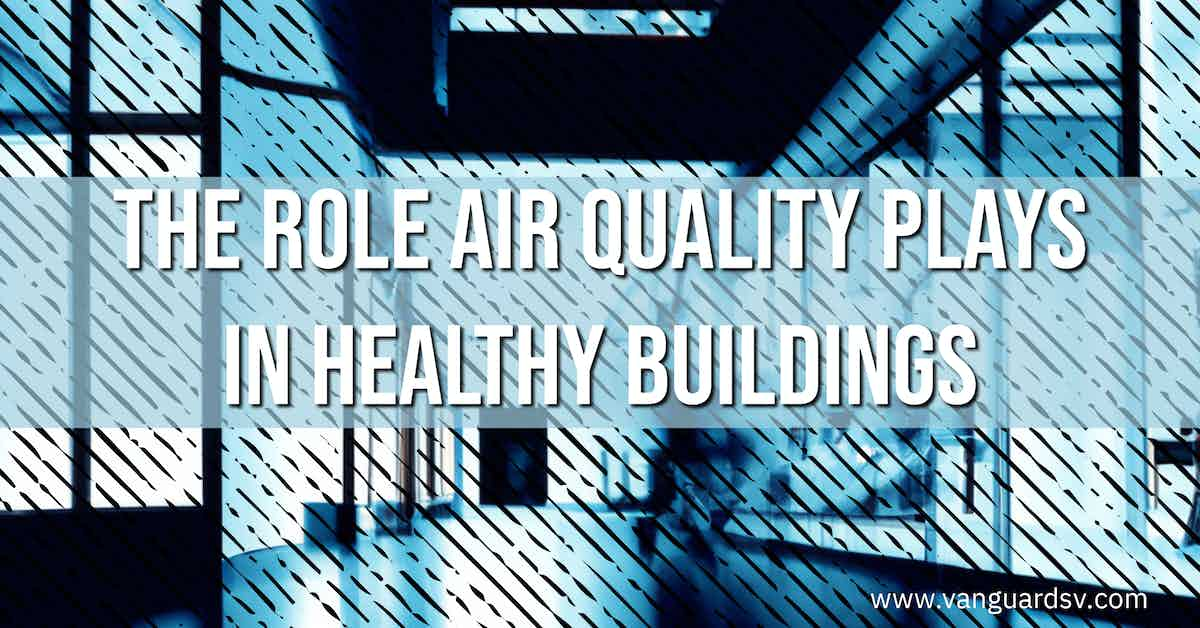Indoor air quality is critical to schools and businesses--playing a crucial role in occupant health, cognitive functions, and quality of life in and outside the facility.

Defining Air Quality and Facility Health
Indoor air quality is somewhat of a complex subject.
Essentially, it measures harmful particulate matter floating through the air inside buildings where humans spend more than 90% of their day.
The concept of a healthy building is also equally complex.
The modern concept of a healthy building comprises several core concepts that focus on improving and ensuring occupant health and performance.
Among the most critical components of facility health is indoor air quality.
Impact of Poor Air Quality on Facility Health
Poor indoor air quality poses significant risks to humanity's health, wealth, and longevity.
Sources of indoor air pollution range from:
- Human activities, such as cleaning and cooking.
- Vapors off-gassing from building materials and;
- Biological contaminants, such as mold and pathogens.
Contaminants commonly found in public office buildings and classrooms include:
- Allergens
- Asbestos
- Carbon Monoxide
- Formaldehyde
- Lead
- Mold
- Pesticides
- Radon
- Smoke
How those contaminants impact human health and performance can vary widely depending on several factors, including pre-existing health conditions and length of exposure.
Common health conditions associated with exposure to poor indoor air quality include:
- Respiratory disease, asthma, and impacts on lung development at early stages.
- Cardiovascular disease.
- Cognitive effects and overall low health, especially in school-aged children, and;
- Lung cancer, typically after long-term exposure to known carcinogens, such as secondhand smoke, asbestos, silica, and chromium.
Adverse impacts on occupant health correspond directly to the quality of the work output by those occupants.
In other words, healthy people tend to work faster, think clearer, and are typically more suited for complex tasks, especially those involving team coordination.
Several studies have documented this phenomenon where intervention protocols were implemented to improve indoor air quality while monitoring several key performance indicators.
According to UL;
In 2015, the authors of the Harvard study also evaluated the results of their previous study in cost/benefit terms.
They found that doubling the ventilation rate would cost less than $40 per person per year in all climate zones investigated, and would improve the performance of workers by 8%.
This was equated with a $6,500 increase in employee productivity per year.
They also updated the numbers, approximating the annual savings of $125 billion in 1993 dollars is roughly $186 billion in 2015 dollars.
They also estimated that even with conservative estimates, the increased productivity of an employee is more than 150 times higher than the energy costs associated with increasing ventilation.
Effects of Indoor Environmental Quality on Performance and Productivity
Strategies for Improving Air Quality
Improving indoor quality requires intervention and design strategies that prevent the introduction of pollutants into a building while moving harmful particulate matter that does enter the building back outside or through a series of HVAC HEPA filtration systems.
Additionally, deploying modern commercial-grade air purifiers at strategic locations throughout the facility will further reduce harmful particulate matter in the air.
A basic example plan could look something like this:
- Upgrade infection prevention and control products to third-party verified green cleaners and disinfectants.
- Open doors and windows when and where possible, especially in occupied portions of the facility.
- Increase mechanical air flow through the HVAC system.
- Upgrade the HVAC HEPA filters to a minimum rating of MERV-13.
- Dust, vacuum, and clean according to established health-first principles and;
- Implement IAQ monitoring and reporting systems.
References & Resources
Takeaway
Indoor air quality impacts everyone.
High-quality indoor air results in lower costs, better health, improved social outcomes, increased profits, and higher-quality work output.
Conversely, low-quality indoor air is, quite literally, killing and bankrupting us.
Onboarding and managing the requisite labor and material resources necessary to ensure the highest standards of cleanliness are achieved and maintained may prove cost-prohibitive for many organizations.
Outsourcing is a proven method for onboarding highly in-demand cleaning and disinfection services and experience for a fraction of the price of maintaining a similar service in-house.
If you would like more information regarding the effectiveness of high-performance infection prevention and control measures, or if you would like to schedule a free, no-obligation on-site assessment of your facility's custodial needs, contact us today for a free quote!
In Bakersfield, CA, call (661) 437-3253
In Fresno, CA, call (559) 206-1059
In Valencia, CA, or Santa Clarita, CA, call (661) 437-3253
In Palmdale, CA, or Lancaster, CA, call (661) 371-4756

